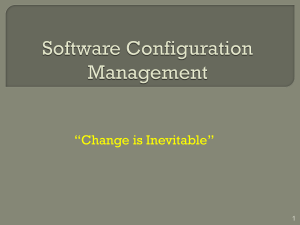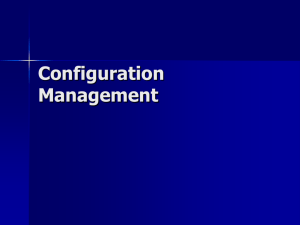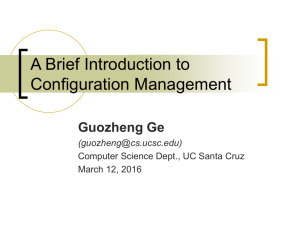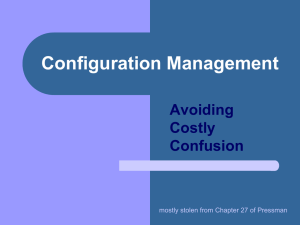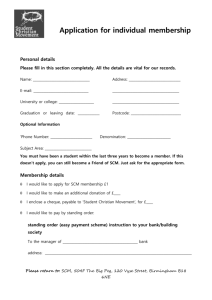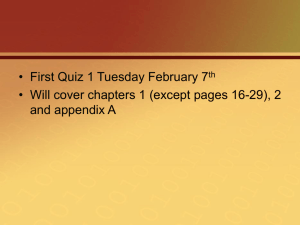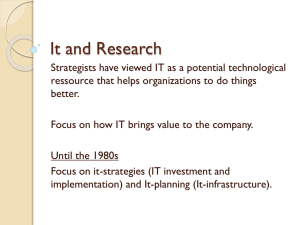1 - Rose
advertisement
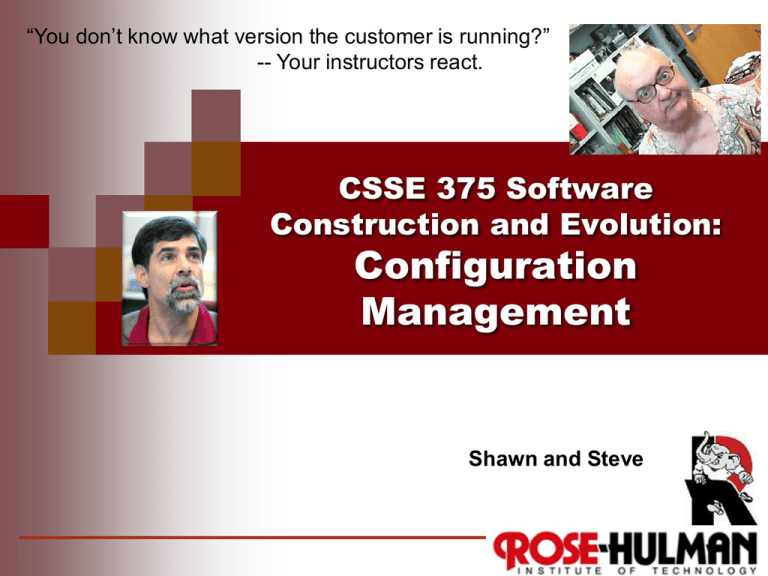
“You don’t know what version the customer is running?” -- Your instructors react. CSSE 375 Software Construction and Evolution: Configuration Management Shawn and Steve Kant these philosophy puns be automated? No, they are Immanuel Kants. 2 Small programs don’t require much formal configuration management. Why do you suppose that software is so much harder to build as it gets older and bigger? Think for 10 seconds… Turn to a neighbor and discuss it for 30 seconds Can we tawlk? Q1 3 Problem: Three Dimensions of Change Multiple people must work on software that is changing More than one version of the software must be supported: Released systems Custom configured systems (different functionality) System(s) under development Software must run on different machines, operating systems… Q2 4 Think about managing changes in your Junior Projects. Now think about how that would be different if your project was integrated with 25 other projects. What would you need to manage industrial strength projects? Think for 25 seconds… Turn to a neighbor and discuss it for a minute Please identify 2 things you would need for large projects 5 What is Software Configuration Management? Definition: Set of management disciplines within the software engineering process to develop and maintain the integrity of a baseline. Description: SCM encompasses the disciplines and techniques of initiating, evaluating and controlling change to software products during and after the software engineering process. Standards (approved by ANSI) IEEE 828: Software Configuration Management Plans IEEE 1042: Guide to Software Configuration Management Q3 6 SCM Basics Identification – identifying software configuration items in a baseline Control – controlling the release of a product and changes to it throughout its lifecycle Status Accounting – recording and reporting of the status of components and changes Auditing and Reviewing – Validating the completeness of a product and that SCM procedures are being followed Q4 7 SCM Definitions (1 of 2) Software Configuration Item (SCI) – A collection of software elements treated as a unit for the purposes of SCM Baseline – 1 or more SCIs that have been formally reviewed and agreed upon and serve as a basis for further development Configuration – A collection of all the elements of a baseline and a description of how they fit together 8 SCM Definitions (2 of 2) Configuration Control Board – Group with the responsibility for reviewing and approving changes to baselines Software [artifacts] – All of the code, specifications, plans, descriptions, processes, and documents associated with a software development effort Version – A specific instance of a baseline or configuration item Above - How a typical CCB operates. 9 Example Configuration Items Product concept specification Software project plans Software requirements specifications Software design descriptions Source code Database descriptions SCM procedures (controlling SCM change) Software release processes Software test documents User documentation Maintenance documentation 10 Example SW Configuration Item Tree “The project” SCI Models Object Model Subsystems Dynamic Model Database .... Code Documents SRS User Interface Data .... SADS .... Unit Test .... 11 For SCM, bring back an oldy, but goodie… 12 SCM Activities Configuration item identification Modeling of the system as a set of evolving components Promotion management Creation Release management Creation of versions for other developers of versions for the clients and users Change management Handling, approval and tracking of change requests Branch management Management of concurrent development Variant management Management of versions intended to coexist 13 Key Tasks for Configuration Managers Define Configuration Items Define Promote /Release Policies Define Activities And Responsibilities Set Up Configuration Management System 14 Let’s say a change is made to the code to incorporate use of a packaged application that replaces the scheduler. How can you account for all the dependencies between the cognizant software artifacts? Think for 15 seconds… Turn to a neighbor and discuss it for 30 seconds Can we tawlk? Q5 15 More on Baselines As systems are developed, a series of baselines is developed, usually after a review (reqts, design, or code reviews, system testing, client acceptance, ...) Developmental baseline (SRS, SADS, Integration Test, ...) Functional baseline (first prototype, alpha, beta releases) Goal: Get first customer experiences with functional system. Product baseline (product) Goal: Coordinate engineering activities. Goal: Coordinate sales and customer support. Many naming schemes for baselines exist (1.0, 6.01a, ...) A 3 digit scheme is quite common: 7.5.5 Release (Customer) Version (Developer) Revision (Developer) 16 Baselines in SCM Baseline A (developmental) Baseline B (functional, first prototype) Baseline C (functional, beta test) Official Release Time How do we manage changes in the baselines? Q6 17 Change Management Change management handles change requests General Change Process Change is requested (this can be done by anyone including users and developers) 2. Change request is assessed against project goals 3. Change is accepted or rejected 4. If it is accepted, the change is assigned to a developer and implemented (otherwise, it’s returned to originators with rationale) 5. The implemented change is audited 1. 18 Controlling Changes Two types of controlling change: Promotion: Internal development state of a software is changed. Release: A changed software system is made visible outside the development organization. Promote Policy Software Engineer Promotion Release Policy Master Directory Release Software Repository User Approaches for controlling change (Change Policy) Informal (good for research type environments and promotions) Formal (good for externally developed CIs and for releases) Q7 19 Standard SCM Directories Programmer’s Directory (IEEE Std: “Dynamic Library”) Completely under control of one programmer Master Directory (IEEE Std: “Controlled Library”) Central directory of all promotions Promotion Central source code archive Release Software Repository (IEEE Std: “Static Library”) Externally released baselines Foo’12 Foo’13 20 Change Policies Change Policies When a promotion or a release is performed, one or more policies apply Purpose of policies is to guarantee that each version, revision, or release conforms to commonly accepted criteria Example change policies: “No developer is allowed to promote source code which cannot be compiled without errors and warnings.” “No baseline can be released without having been beta-tested by at least 500 external users.” 21 Version vs. Revision vs. Release Version: An initial release or re-release of a configuration item associated with a complete compilation or recompilation of the item. Different versions have different functionality. Revision: Question: Is Windows 8 a new version or a new revision compared to Windows 7? Change to a version that corrects only errors in the design/code, but does not affect the documented functionality. Release: The formal distribution of an approved version. Q8 22 Software Configuration Management Plan Defines the types of artifacts to be managed and a naming scheme Defines who takes responsibility for the CM procedures and creation of baselines Defines policies for change control and version management Describes tools to be used to assist the CM process and any limitations on their use Defines the configuration management database used to record configuration information 23 Software Configuration Management Plan 1. Introduction (WHY?) Describes purpose, scope of application, key terms and references 2. Management (WHO?) Identifies the responsibilities and authorities for accomplishing the planned configuration management activities 4. Schedule (WHEN?) Establishes the sequence and coordination of the SCM activities with project mile stones 5. Resources (HOW?) Identifies tools and techniques required for the implementation of the SCMP 6. Maintenance 3. Activities (WHAT?) Identifies the activities to be performed in applying to the project. Identifies activities and responsibilities on how the SCMP will be kept current during the lifecycle of the project. 24 Types of Audits In-process Audits Verify consistency of the design as it evolves through development process Functional Audits Verify that functionality and performance are consistent with requirements defined in the SRS Physical Audits Verify that the as-built version of software and documentation are internally consistent and ready for delivery Quality System Audits Independent assessment of the compliance to the software QA plan 25
